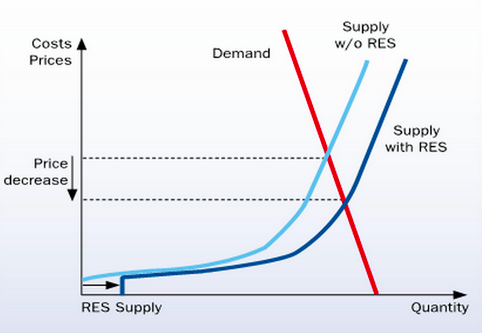
High levels of solar PV penetration stand to upend electricity markets as we know them today. In continuing our mini-series of “How Much Solar Can the Grid Handle?” this article looks to briefly introduce potential shifts in wholesale electricity price discovery in response to high levels of solar penetration and potential mitigation measures to ensure long-term economic viability.

To appreciate potential deviations from current market conditions is to first understand price discovery in deregulated wholesale markets today. Discovery begins as generators bid into day-ahead markets at their marginal cost of generation. Plants with the lowest operating costs are selected first with additional capacity added in merit order of marginal generation cost until anticipated demand is met. By selecting generators in ascending order of marginal cost, demand is satisfied and electricity cost minimized.

Unlike fossil generators which are exposed to considerable and volatile operations costs in the form of fuel and maintenance, solar presents minimal variable costs. Absent of fuel costs, energy from solar generators is bid into the market at prices near zero. At low levels of PV penetration this merit order effect has little impact on the marginal cost of electricity within a given interconnection. Conditions change at high levels of solar penetration as a significant quantity of high cost fossil generation is displaced. Taken to an extreme, a grid dominated by solar could foreseeably lower the market price of energy to near zero during times of peak solar production. Under these conditions, further generator investment would come to a halt as solar effectively prices itself out of the market.
While the scenario above is highly exacerbated, market conditions and the evolution of price discovery must be reevaluated as solar continues to increase in generation share. Acting in opposition to price decay, significant levels of PV penetration will increase the cycling costs of existing fossil generators due to swings in PV production. Cycling costs encompass the maintenance and fuel costs associated with generation curtailment and the subsequent production ramp-up of thermal generators. Every time the facility faces cycling conditions, enormous thermal stress is placed upon the inner workings of the plant resulting in premature replacement of parts and increased downtime. With enough PV in the market, cycling costs will drive the marginal costs of fossil plants up thereby maintaining the rate recovery of solar investments.
As we have seen, high levels of PV penetration can potentially catalyze diverging pressure on wholesale prices. To maintain significant solar capacity and encourage further investment, mitigation strategies could be employed to ensure solar remains economically valuable even at high levels of penetration. One of the top mitigation measures to ensure long-term economic viability of solar and other renewable sources of energy is large scale storage located at switching stations, large solar fields and distributed sites. As we have discussed in past articles, storage can perform numerous grid services including frequency regulation and reserves. Most importantly, storage capacity allows for peak shifting of solar resources to cover demand spikes that occur after sunset effectively increasing the value of the solar resource.
Strategic siting of future solar resources will also increase the value of solar when bidding into the market. Often PV fields are sited far from demand centers where land is cheaper and obstructions few. These fields may also require costly transmission infrastructure to deliver energy to distribution substations. By intelligently siting solar resources near demand centers or areas that frequently experience grid congestion the value of the energy generated by the facility is maximized and subsequent infrastructure costs kept to a minimum.
Storage capacity and strategically sited solar resources are just a couple measures that will ensure that solar remains competitive in wholesale markets in the future. Real time wholesale pricing and the advent of a price on carbon emissions may also ensure solar resources are appropriately priced into the marketplace.